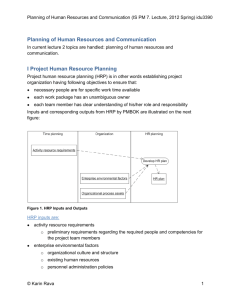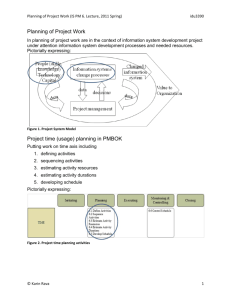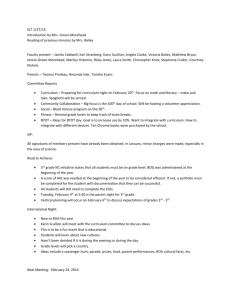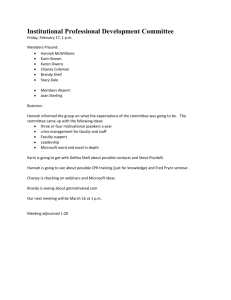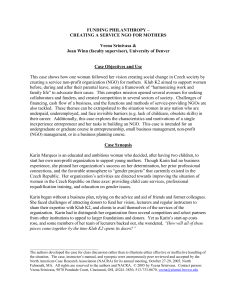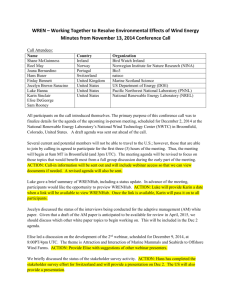Project organizational planning objectives are to ensure that
advertisement
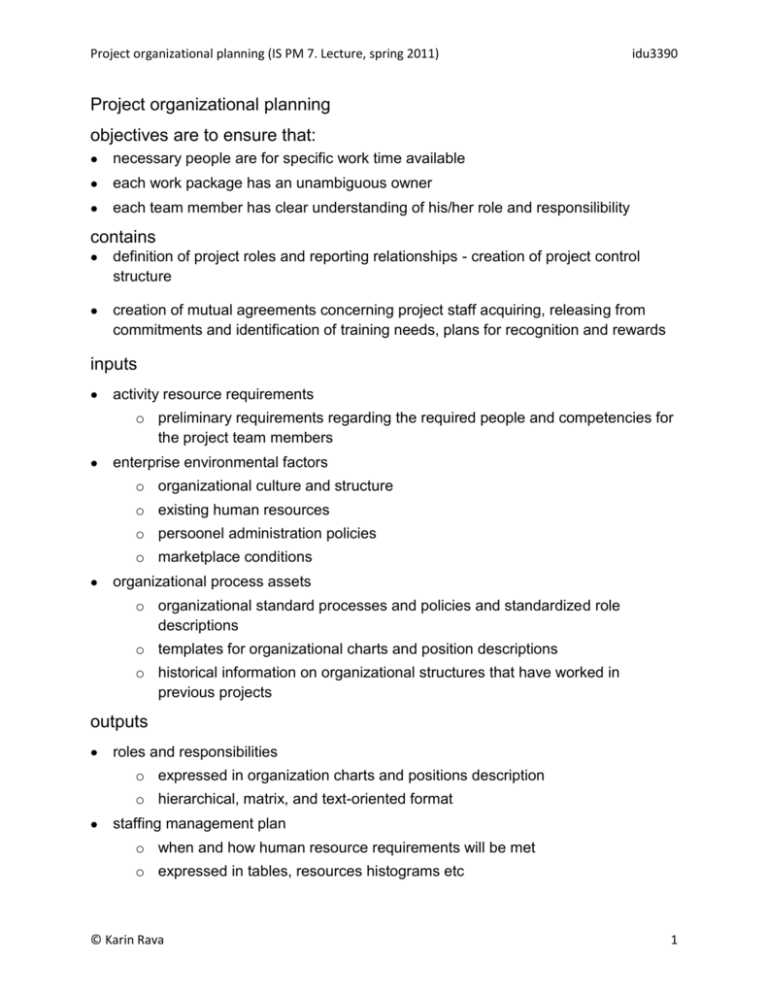
Project organizational planning (IS PM 7. Lecture, spring 2011) idu3390 Project organizational planning objectives are to ensure that: necessary people are for specific work time available each work package has an unambiguous owner each team member has clear understanding of his/her role and responsilibility contains definition of project roles and reporting relationships - creation of project control structure creation of mutual agreements concerning project staff acquiring, releasing from commitments and identification of training needs, plans for recognition and rewards inputs activity resource requirements o preliminary requirements regarding the required people and competencies for the project team members enterprise environmental factors o organizational culture and structure o existing human resources o persoonel administration policies o marketplace conditions organizational process assets o organizational standard processes and policies and standardized role descriptions o templates for organizational charts and position descriptions o historical information on organizational structures that have worked in previous projects outputs roles and responsibilities o expressed in organization charts and positions description o hierarchical, matrix, and text-oriented format staffing management plan o when and how human resource requirements will be met o expressed in tables, resources histograms etc © Karin Rava 1 Project organizational planning (IS PM 7. Lecture, spring 2011) idu3390 Human resource planning in PMBOK Consists on following steps: 1. defining roles 2. defining reporting relationships and responsibilities 3. establishing staffing management plan Pictorially expressing: Figure 1. Human resource planning by PMBOK Step 1 - defining roles Role – set of responsibilities, authorities and competencies Responsibilities – work what is expected from team member to get a result Authority - right to apply project resources, make decisions and sign approvals; right to choose work method, accept quality and respond to project disagreements Competency – skills and capabilities, what are needes to komplete tasks With role are defined responsibilities, inputs and outputs to implement them Roles in different methodologies RUP roles - analysts, developers, testers, managers, others; OpenUP roles - analysts, whatever role, architect, developer, project manager, stakeholder, tester; Scrum roles – product owner, scrum master, scrum team; XP roles - client, tester, programmer, tracker, coach Here is one table illustrating these roles: Table 1. Roles in agile approaches Concept Generic Agile XP Scrum DSDM Number of teams 1–6 1 team per project 1 – 4 or more 1–6 © Karin Rava 2 Project organizational planning (IS PM 7. Lecture, spring 2011) idu3390 Team size 2 – 10 3 – 16 5–9 2–6 Team Roles Product Owner, Agile Project Manager, Technical Lead, Developer, Tester, UX Designer Customer, Programmer, Tester, Tracker, Coach Scrum master, Scrum Team (Experienced Engineer, Junior Engineer, [QA Tester], [Writer]) Team Leader, Ambassador User, [Advisor User], Senior Developer, Developer, Scribe NonTeam Roles Business Sponsor, Agile Programme Manager, Architect, Agile Coach Big Boss Scrum master, Product Owner Visionary, Executive Sponsor, Project Manager, Technical Co-ordinator, Facilitator Project manager role in different methodologies In RUP: acquires resources sets priorities coordinates collaboration with project customer and system end users tries to keep project team on the right course creates procedures for project outcomes In OpenUP guides team to get successful result and customer to accept product estimates project risks and controls them trough mitigation strategies Step 2 – defining of report relationships and responsibilities Putting in place project control and information flow structure. In other words establishing project organization structure expressed in organization chart hierarchical-type charts – show positions and relationships in a graphic, topp-down method matrix-based charts – illustrate the connections between work that needs to be done and project team members o RAM (Responsibility Assignment Matrix) o RACI (Responsible, Approve/Accountable, Consult, Inform) text-oriented formats – detailed description of team member responsibilities, authority, competencies and qualifications One example of project organizational structure: © Karin Rava 3 Project organizational planning (IS PM 7. Lecture, spring 2011) idu3390 Figure 2. Project organizational structure example One example of responsibility assignment matrix: Table 2. Responsibility assignment matrix example One example of RACI matrix: Table 3. RACI matrix example © Karin Rava 4 Project organizational planning (IS PM 7. Lecture, spring 2011) idu3390 Description of assignment roles Responsible o Individual/s who perform a task/activity; the doer, responsible for action/implementation o The degree of responsibility is defined by the Accountable person o Responsibility can be shared o While Accountability can NOT be delegated, Responsibility can be delegated Accountable o The individual who has ultimate accountability and authority o There is only one accountable (A) to each task/activity o Accountability is assigned at the lowest level and implied at higher levels o Accountability cannot be delegated Consulted o The individuals to be consulted prior to a final decision or action is taken o Two-way communication Informed o The individuals that need to be informed after a decision or action is taken RACI benefits encourages teamwork by clarifying roles and responsibilities eliminates duplication of effort reduces misunderstanding improves communication - make sure people are not „left out‟ determines ownership helps clarify activities and tasks in a process reduces bad decisions by ensuring the correct people are involved clarifies hand-offs and boundaries improves cross-functional view for all employees Considerations about RACI Accountable o too many A‟s? - Probably a sign of confusion - no one will be sure who really had the task and each individual will probably have a different approach and/or expectation(s). o multiple “A”ccountable and unrelated resources can cause conflicts in differences of opinion o you should be sure the team members are co-chairs, co-leads, or at least in similar roles and will collaborate well together. © Karin Rava 5 Project organizational planning (IS PM 7. Lecture, spring 2011) idu3390 o many A‟s - Is this person a bottleneck? Can these tasks be shared or segregated? o multiple A‟s should be kept to a minimum or each vertical column should have only ONE Accountable Responsible o multiple “R”esponsible can cause unnecessary or duplicate work. o make one team member responsible for each task. o lot‟s of R‟s - The individual may have too much to do - can the activities be broken into small sections and split out to others? o each vertical column should have one Responsible, but can have more in some situations of shared responsibility. o with no R‟s a gap occurs - Is the task being completed? Assign Responsibility. Consult o Form one side multiple “C”onsulted is desirable to collect input from all potential subject matter experts. o From ohter side - minimize the number of Consults - Make sure the consult is necessary and not just a „feel good‟ contact. Inform o Keeping multiple people “I”nformed helps develop capacity. o If a team member is absent or unable to carry out work for any reason, you have developed a successor for that role. o Too many I‟s? Maybe some people only need to be informed if exceptional circumstances occur - Build the appropriate criteria into the process In general: in general, any team member should have only one role. if any column is empty, consider if that resource is necessary for the project. no empty spaces in a row - Does this person need to be involved in every step? Try to reduce C‟s and I‟s First. completely empty row - Why was this function included? Are we missing including them when they should be? Can the function be correctly eliminated from the process? Step 3 - defining project staffing management plan Describes when and how human resource requirements will be met includes © Karin Rava 6 Project organizational planning (IS PM 7. Lecture, spring 2011) idu3390 staff acquisition - how and through what methods the people needed for the project will be acquired, which may include both personnel internal to the performing organization and external to it, such as consultants resource calendars, timetables, and histograms - information on when resources will be needed and in what durations, shown through calendars, timetables, and histograms training - formal plan for project team member training, though informal training will also occur compliance and safety - any measures that will be taken to ensure that any safety, governmental, regulatory, organizational, or contractual obligations are followed that are applicable to human resource requirements team performance assessments - include any team performance goals, and how the overall performance of the project team will be measured and evaluated project performance appraisals - include the procedures, methods, and guidelines for the performance appraisal of individual project team members recognition and rewards - details the approaches that will be taken for promoting and reinforcing desired behavior, including the costs associated with any recognition or reward program staff release criteria - describes how team members will be released from the project; how payment for work completed will be handled for the departing team member One example of staffing plan: Table 4. Staffing plan example One example of resource histogram: © Karin Rava 7 Project organizational planning (IS PM 7. Lecture, spring 2011) idu3390 Figure 3. Resource histogram example Limitations in supplying with personal project member location in main organization team members preferences for composition, role allocation and fulfillment dependence of personal skills and capabilities availability of resources team communication model conditioned by development methodology Being project team member depends on: rules, on what projects in main organization are organized management structure in customer and performer organization project members subordination relationships in main organization Organizational structure Organizational structure is an enterprise environmental factor which can affect the availability of resources and influence how projects are conducted Organizations can be: Not projectized - nothing is done with projects Projectized - project services are offered outside the company (development companies) or project services are offered inside the company (IT department) The result of bounding together main organization with project organization we can get functional, projectized, matrix or composed organization. Functional organization each employee has one clear superior © Karin Rava 8 Project organizational planning (IS PM 7. Lecture, spring 2011) idu3390 is based on departmental, specialty, or business lines, such as accounting, marketing, sales, customer service, information systems, and so on the scope of the project is usually limited to the boundaries of the function consultations are held by heads of different departments Pictorially: Figure 4. Functional organization Projectized organization team members are often co-located most of the organization‟s resources are involved in project work project managers have a great deal of independence and authority projectized organizations often have organizational units called departments, but these groups either report directly to the project manager or provide support services to the various projects Pictorially: © Karin Rava 9 Project organizational planning (IS PM 7. Lecture, spring 2011) idu3390 Figure 5. Projectized organization Matrix organization a blend of functional and projectized characteristics Weak matrices maintain many of the characteristics of a functional organization, and the project manager role is more of a coordinator than that of a true project manager Strong matrices have many of the characteristics of the projectized organization, and can have full-time project managers with considerable authority and full-time project administrative staff Balanced matrix organization recognizes the need for a project manager, it does not provide the project manager with the full authority over the project and project funding Weak matrix organization pictorially: © Karin Rava 10 Project organizational planning (IS PM 7. Lecture, spring 2011) idu3390 Figure 6. Weak matrix organization Strong matrix organization pictorially: Figure 7. Strong matrix organization Balanced matrix organization pictorially: © Karin Rava 11 Project organizational planning (IS PM 7. Lecture, spring 2011) idu3390 Figure 8. Balanced matrix organization Composed organization Composed organization involves all previously described structures at various levels, pictorially: Figure 9. Composed organization Project manager is determined Pending on his/her position in organization by resource manager – superior of project manager by project sponsor – project initiator © Karin Rava 12 Project organizational planning (IS PM 7. Lecture, spring 2011) idu3390 by project manager him-/herself Following table shows key project-related characteristics of the major types of organizational structures: Table 5. Organizational influences on projects Used Literature Alex Sherrer, Project Management Road Trip, Ch. 9 - Human Resource Management, http://www.pmroadtrip.com/pmpv4_09.html Simon Wallace , Project Structure and organisation, http://www.epmbook.com/structure Steven Thomas, „Agile Roles and Responsibilities“, http://itsadeliverything.com/agile-roles-and-responsibilities ExpressionLab, „Agile Roles and Responsibilities“, http://www.expressionlab.com/2010/1/9/agile-roles-and-responsibilities OpenUP Roles, http://www.utm.mx/~caff/doc/OpenUPWeb/openup/rolesets/openup_roles_5CDDEE DA.html Mattias Skarin, „Agile Roles“, http://blog.crisp.se/mattiasskarin/files/agileroles/AgileRoles.pdf Scott W. Amber, Roles on Agile Teams: from Small to Large Teams, http://www.ambysoft.com/essays/agileRoles.html © Karin Rava 13 Project organizational planning (IS PM 7. Lecture, spring 2011) idu3390 Mike Griffiths, Develop Human Resource Plan, http://leadinganswers.typepad.com/leading_answers/91-develop-human-resourceplan.html Doreen Myers, „Project Communications and Human Resource Management, Unit #3 Project Human Resource Planning“, www.conestogac.on.ca/~dmyers/hrmanagement/pmcommhrModule_3.ppt Project Management Advisor , „Develop Project Staffing Plan“, http://pma.doit.wisc.edu/plan/2-2/tools.html Project Open, „HR Project Staffing“, http://www.projectopen.org/documentation/process_hr_project_staffing Ray W. Frohnhoefer, „RACI and RACI-VS“, http://www.pmhut.com/raci-and-raci-vs Steven Bonacorsi, „RACI Diagram / RACI Matrix - A Complete Definition“, http://www.pmhut.com/raci-diagram-raci-matrix-a-complete-definition Project management Advisor, Develop Project Staffing Plan, http://pma.doit.wisc.edu/plan/2-2/tools.html Shravan Chinnagangannagari, “Organizational Structure”, http://www.shravan.org/2007/05/organizational-structure.html Organizational Theory, http://www.europm.com/ot.html © Karin Rava 14
